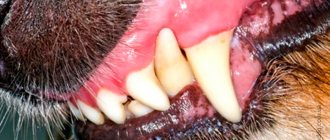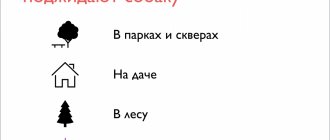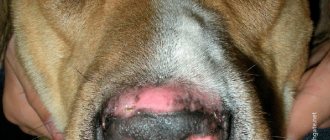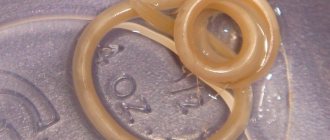Infectious hepatitis in dogs in veterinary medicine is called adenovirus, viral hepatitis and fulminant liver failure. It belongs to the category of serious contagious viral diseases, characterized by very extensive symptoms and causing damage to liver cells.
Any dog can get hepatitis, regardless of breed and age category. Most often, puppies aged from one to three months are affected. In pets after three years of age, this disease is rarely diagnosed. The disease can occur in isolated cases or have epizootic outbreaks.
Etiology of the disease
Infectious hepatitis in dogs is caused by the DNA virus Adenovirus caninae. All its strains have equally low virulence. It is similar to laryngotracheitis. The virus is resistant to low and high temperatures. It is also unaffected by chloroform, some acids, ether and methanol.
The virus begins to develop in the nasopharynx, larynx, esophagus and tonsils. Later it descends to the internal organs, submandibular and retropharyngeal lymph nodes. However, it is most localized in liver cells. The waste products of the virus cause the development of inflammation, degeneration and necrotics of the liver, leading to disruption of its functioning. Malfunctions in the functioning of the gastrointestinal tract and central nervous system also begin.
In addition, destruction of the renal vessels occurs. Multiple foci of inflammation develop, hemorrhages and perivascular edema appear. The poisons and toxic substances released by the adenovirus destroy the vascular walls, increasing their permeability. If you do not help the animal in time, it will die.
Hepatitis in animals: classification, etiology, diagnosis, treatment and prevention.
- Inflammation of the liver of a diffuse nature, accompanied by hyperemia, cellular infiltration, dystrophy, necrosis and lysis of hepatocytes and other structural elements, severe liver failure.
Classification. There are acute (parenchymal) hepatitis, which occurs with inflammation of the organ parenchyma, and chronic hepatitis , characterized by inflammatory-dystrophic changes with moderate fibrosis.
1. Infectious (invasive) hepatitis.
2. Toxic hepatitis
3. Drug-induced hepatitis
4. Autoimmune hepatitis.
5. Feed hepatitis.
Etiology.
1. Infectious (invasive) hepatitis. Hepatitis of infectious origin includes viral hepatitis: dogs, fur-bearing animals, ducklings and other animals. Inflammation of the liver occurs with leptospirosis, salmonellosis and many other bacterial diseases.
Of the pathogenic protozoa, hepatitis is most often caused by pathogens of animal piroplasmosis (babesiosis, piroplasmosis), theileriosis (theileriosis of cattle, sheep and goats), eimeriosis (eimeriosis of rabbits, cattle, sheep), toxoplasmosis (toxoplasmosis of cats and dogs), trypanosomiasis ( suauru of horses, donkeys, breeding disease of horses), leishmaniasis of dogs, balantidiasis of pigs, etc.
2. Toxic hepatitis . Hepatitis is caused by exogenous and endogenous poisons: toxins of pathogenic fungi that affect grain fodder, straw, silage, haylage; chemicals - granosan, arsenic, mercury, sublimate, alkaloids of lupine and other plants, potato solanine, etc.
3. Medicinal. Drug-induced hepatitis is possible after using erythromycin, tetracycline, terramycin, biomycin, etc.
4. Stern. In piglets, hepatitis occurs when they are fed spoiled fish, meat and bone meal, and rancid fat.
Improper nutrition, giving an animal food that is not typical for it, directly affects its liver. First, inflammation develops in the biliary system, in particular in the bile ducts and gallbladder. Further, if the disease is not eliminated in time, inflammation can spread to the entire organ.
Chronic hepatitis is often a consequence of acute hepatitis; it can also develop as an independent disease with prolonged exposure to toxic substances. The transition of hepatosis to chronic hepatitis is also possible.
Pathogenesis . General pathogenetic mechanisms are cellular infiltration, protein-carbohydrate and fatty degeneration, necrosis and lysis of liver cells. The predominant link in acute hepatitis is necrosis and lysis of hepatocytes, in chronic hepatitis - their degeneration .
Features of the pathogenesis of hepatitis depend on the etiological factor; specific hepatitis viruses, the causative agent of leptospirosis, have a direct effect on liver cells, which settle and multiply in liver cells, causing their degeneration, necrosis and death.
The harmful effect of pathogenic protozoa on the liver is that piroplasmas and babesia, multiplying in red blood cells, destroy them. A lot of free bilirubin is formed, which does not have time to be neutralized. It is a very toxic substance and causes the death of liver cells and their autolysis.
When the liver is damaged by helminths, hepatitis can also be caused due to mechanical damage to the liver tissue, allergization of it by helminth waste products. In hepatitis, along with cell death, autolysis occurs. The integrity of intralobular capillaries, interlobular veins and arteries, as well as capillaries of the bile ducts is impaired, which leads to a decrease in bile formation and bile excretion, and hepatic jaundice develops.
Damaged liver cells lose the ability to synthesize glycogen, glucose, blood coagulation factors, albumin, participate in metabolic reactions of amino acids, fatty acids and other metabolic products, utilize ammonia and other harmful products, and conjugate bilirubin. A decrease in the barrier function of the liver is accompanied by the accumulation of harmful substances in the blood and tissues that act on the kidneys, heart and other organs, causing dystrophy and even necrosis in them.
With hepatitis, the function of the central nervous system (CNS), digestive organs, heart, kidneys, etc. is impaired.
Symptoms.
1. General symptoms include depression, decrease or loss of appetite, increased body temperature, increased liver volume, and pain due to capsule tension.
2. The syndrome of hepatic (parenchymal) jaundice is clearly manifested: dyspeptic disorders, itching of the skin, scratching, intense yellow discoloration of the mucous membranes and non-pigmented areas of the skin, increased levels of bilirubin in the blood, mainly due to free, etc. In acute and chronic hepatitis, a syndrome is observed liver failure, manifested in disruption of the most important functions of the body - indigestion, poor absorption of fats, increased bleeding, general intoxication, sudden depression up to and including a coma, loss of fatness and productivity, exhaustion, etc.
3. Hepatitis is accompanied by an enlarged spleen.
4. In the blood, the albumin content decreases and the amount of alpha and beta globulins increases, the concentration of ammonia, cholesterol, the activity of AST, ALAT, LDH, and the activity of cholinesterase decreases. Urine in hepatitis is dark in color due to the release of bilirubin and urobilinogens by the kidneys.
Diagnosis and differential diagnosis . Anamnesis data, results of clinical and laboratory tests are taken into account. It is necessary to exclude liver cirrhosis, hepatosis, cholecystitis and cholangitis .
· Liver cirrhosis occurs chronically without fever. The liver is dense, the spleen is enlarged.
· Acute hepatitis differs from hepatosis in etiology, severity, and temperature reaction.
· Chronic hepatitis is difficult to distinguish from hepatosis. With fatty hepatosis, the spleen is not enlarged.
Treatment.
1. The primary cause is established, and in case of invasive or infectious diseases, etiotropic therapy is carried out. Poor quality feed is excluded from the diet, feeding of fatty foods is limited, haylage, cereal concentrates, bran mash, root vegetables or potatoes are prescribed. Feeding foods rich in sugars should be limited, as this leads to increased lipogenesis in the liver.
hepatoprotectors ) and drugs with anti-inflammatory and immunosuppressive effects are mainly used
3. Preparations of vitamins A, E, C, B1, B6, B12, cocarboxylase, lipoic acid, essentiale and others in appropriate doses are used as hepatoprotectors.
4. Under the influence of retinol , glucose biosynthesis improves and oxidative processes in the liver are accelerated.
5. Tocopherol has an antioxidant effect, prevents fatty infiltration and liver degeneration.
6. Under the influence of ascorbic acid, the phagocytic activity of reticulohistiocytic cells of the liver, vitamin K and its analogue vikasol increases, and the synthesis in the liver of prothrombin, proconvertin and other blood clotting factors is stimulated.
7. Thiamine accelerates the synthesis of carbohydrates from lactic and pyruvic acids, the conversion of glucose into fructose, regulates blood sugar levels, pyridoxine is involved in the processes of decarboxylation and transamination of amino acids in the liver.
8. Cyanocobalamin is given orally, but more often it is administered intramuscularly as a substance that increases the detoxifying function of the liver. The course of treatment with vitamin preparations is 15-30 days.
9. Cocarboxylase, Essentiale, lipoic acid are prescribed in individual doses for a course of 15-30 days or more.
10. The use of anti-inflammatory and immunosuppressive drugs (prednisolone) is limited. To neutralize ammonia, it is recommended to administer glutamic acid 0.5-1 g per 100 kg of animal weight. For chronic hepatitis, choleretic agents are given (magnesium sulfate, oxafenamide, allochol, etc.).
Prevention. Carry out general and special measures to prevent the occurrence of infectious and invasive diseases, and carry out their timely treatment. The use of spoiled and low-quality feed is not allowed.
How can a dog get hepatitis?
The most common way of infection is contact of a sick dog with a healthy one. Infectious hepatitis of dogs is transmitted through contact with feces, urine and other secretions of a sick individual.
In addition, a dog can get sick by eating from a bowl or drinking from the drinking bowl of a sick animal. The risk group includes pets with weak immune systems. Animals that are not properly kept, fed, or monitored for their health often get sick.
Types and reasons
The inflammatory process in the liver accumulates a certain substance that the organ can neither neutralize nor remove. Acute one-time intoxication causes acute hepatitis, chronic liver damage causes a chronic course of the disease.
Infectious
Even if the infection is not localized in the liver, it still suffers. Any toxins released by pathogenic fungi, bacteria, viruses or parasites enter the liver along with the blood. Infectious hepatitis in cats occurs in acute and chronic forms with equal frequency.
Young, elderly, weakened, unvaccinated, and untreated pets for parasites are more likely to suffer. Crowding, unsanitary conditions, free range, and unbalanced nutrition increase the risk of infection. The main treatment is aimed at combating the factor that led to inflammation. The prognosis is cautious and depends on the general condition of the cat.
Toxic
More often we are talking about acute poisoning, but sometimes the toxin reaches the liver for years. With timely treatment, acute conditions are treated without consequences in 90% of cases. When it comes to long-term intoxication, the organ is already partially destroyed, which worsens the prognosis. Toxic hepatitis in a cat is provoked by:
- medicines
- fertilizers, household chemicals
- poor quality food
- spoiled food
- poisonous plants
- poisoned mice
Conjunctivitis
Ataxia
Cholecystitis
It is not necessary for the cat to ingest the poison. Some pesticides, cheap cosmetics and products for external parasites can lead to intoxication after contact with the skin. Or the cat will swallow the poison by getting dirty and licking itself. Rare water changes lead to poisoning, especially in summer.
Cholangiohepatitis
Inflammation of the liver is preceded by inflammation of the bile ducts (cholangitis) or triaditis - the pancreas, bile ducts, and intestines are simultaneously affected. As a result, intestinal bacteria enter the liver duct. The same picture is given by blockage of the bile ducts, for example, when infected with helminths.
Cholangiohepatitis in cats is provoked by many factors: congenital pathologies, obesity, allergies, fungi and bacteria, metabolic disorders. More often the disease is chronic. Adults and older animals are prone. The therapy is long-term, correcting the functioning of the gastrointestinal tract, sometimes surgical intervention is required.
Forms of viral hepatitis in dogs
The incubation period for the disease lasts from six to fifteen days. Hepatitis is divided into four groups. It happens:
- lightning fast;
- sharp;
- chronic;
- latent.
Each form has its own course and forecasts.
Fulminant hepatitis
Fulminant hepatitis leads to the death of the animal within two to twelve hours. Most often, the dog has convulsions, but jaundice does not have time to develop. Lifetime diagnosis of the disease in an animal does not produce results. This course of the disease does not occur in vaccinated dogs.
Acute hepatitis
The acute course can last from two to ten days. A sick dog becomes lethargic, apathetic and loses its appetite. He has vomiting of bile and diarrhea with blood. The temperature rises to maximum levels, breathing is depressed, and tachycardia develops.
There is an enlargement of the lymph nodes and liver. Also, during an ultrasound examination, fluid accumulation in the peritoneum is often noted. It accumulates due to compression of the portal vein by the liver and poor circulation. A sweetish, fetid odor begins to emanate from the mouth.
Chronic hepatitis
The chronic type of disease develops in adult, vaccinated dogs. It does not have clear symptoms. The animal occasionally experiences vomiting and upset stools. Chronicle pets have a low weight, dull coat and are characterized by low activity. In addition, itching may occur, which cannot be relieved with antiallergic drugs.
Latent hepatitis
This type of disease is asymptomatic. The virus remains dormant for a long time. However, when the immune system weakens, it wakes up and goes into the acute phase. Stress, poor nutrition or pregnancy can weaken the body's defenses. Since the disease remains in the body in an inactive state for a long time, it will not be possible to determine where and under what circumstances the dog became infected.
The most dangerous form of the disease is fulminant hepatitis. When it occurs, the animal cannot be saved.
Clinical symptoms of acute hepatitis
Acute hepatitis
is usually accompanied by:
- high temperature;
- anorexia;
- weakness;
- vomiting;
- diarrhea;
- unpleasant odor from the mouth.
As the disease progresses, yellowness of the mucous membranes, pain on palpation and slight enlargement of the liver appear, and possible discoloration of stool (acholia). In severe cases, liver failure, a tendency to bleeding, hypoglycemia, hepatoencephalopathy (cerebral edema, convulsions, agitation), and hepatic coma develop.
In a biochemical blood test, the level of liver enzymes AST and ALT increases significantly (up to 30-fold), the levels of alkaline phosphatase, total and direct bilirubin are often increased (but not always), and albumin decreases. Increased bilirubin may also be observed in the urine. According to a general blood test, leukocytosis and lymphopenia are often observed; with the development of liver failure, non-regenerative anemia is observed.
Chronic hepatitis
At first they often occur unnoticed and end in liver failure due to lipidosis, cirrhosis or fibrosis of the liver. Chronic hepatitis is often characterized as hepatopathy lasting more than 3 months, detected by a persistent increase in the level of liver enzymes in the absence of exogenous damaging factors, since the pathological process once begun continues after the damaging factor has been eliminated. In this case, nonspecific changes and clinical signs (vomiting, diarrhea) are noted, which began some time ago as a result of the negative effect of various etiological factors on hepatocytes. The progressive course of the disease can be explained both by genetic predisposition and by the difference between the body's response and the damage caused by exposure to pathogenic factors.
There is also a distinction between chronic active hepatitis and chronic persistent hepatitis. Chronic active hepatitis is rare and is accompanied by noticeable clinical symptoms due to liver failure and the disease ends in death. Chronic persistent hepatitis, in contrast, is relatively benign with little tendency toward cirrhosis and may resolve spontaneously. Chronic persistent hepatitis occurs with minor clinical signs or without them at all; the disease is detected by elevated levels of liver enzymes.
Symptoms of infectious hepatitis in dogs
Depending on the form of the disease, infectious hepatitis in dogs will occur with different symptoms. Each form has its own characteristic signs, but there are also general symptoms indicating the development of the disease.
The presence of hepatitis in a dog is indicated by an increase in temperature, poor appetite, thirst, depression and apathy. The animal does not respond to attention from the owner and is reluctant to go for a walk. The pet tries to lie on its left side, and when the area under the right rib is palpated, it begins to writhe and whine. At the same time, the liver increases in size and becomes very inflamed.
In addition to elevated temperatures and refusal to eat, the dog develops the following symptoms:
- lethargy, lack of response to stimuli, desire to hide and lie down more;
- lack of appetite and constant thirst;
- rapid breathing, stuffy nose, enlarged submandibular lymph nodes;
- diarrhea mixed with blood and mucus, vomiting with bile;
- dark colored urine;
- weakness and numbness of the limbs;
- yellowing of the eyeballs and mucous membranes;
- bleeding gums.
When the disease passes into the chronic stage, the symptoms change somewhat and acquire disastrous consequences for the body. Since chronic hepatitis develops over a long period of time, its symptoms will include:
- catarrhal symptoms (discharge from the nose and eyes);
- fever, photophobia and spatial disorientation;
- clouding of the cornea;
- edema and convulsive syndrome;
- weight loss, low-grade fever;
- problems with bowel movements and gas formation;
- periodic vomiting.
These symptoms of infectious hepatitis in dogs are not as obvious as in its acute course, so it will be more difficult to identify the disease. However, if the owner notices at least one of the above signs in the pet, he should immediately take him to the veterinarian.
Parvovirus gastroenteritis
In recent years, dog owners and veterinarians have had to deal with a new mass disease, which is accompanied by a disorder of the normal functions of the gastrointestinal tract (vomiting, diarrhea with blood) and cardiovascular failure, and ends in most cases with the death of animals - both puppies and and adult dogs.
Outbreaks of this disease have been registered not only here, but also in many countries around the world: the USA, Canada, Austria, England, Australia, France, Germany, Italy, Greece, Czechoslovakia, East Germany, Hungary, Japan, India, etc.
Researchers isolated the causative agent of the infection. It turned out to be parvovirus, the smallest virus ever isolated from vertebrates. Parvovirus is very resistant to external influences; it does not die in the cold, or when heated to 60°C for an hour. And only boiling kills the virus instantly.
Incidence of dogs with parvovirus gastroenteritis
has its own laws. All dogs, regardless of breed, are susceptible to this disease. It is widespread, usually begins in early spring, reaches a maximum of cases in summer, lasts until autumn and gradually subsides towards winter. The possibility of infection depends on the age of the dog: young dogs from 2.5-3 months to 1 year and adults aged eight to nine years, when the body’s defenses decrease, are most susceptible to this virus. In addition, males are more likely to get sick, females are less susceptible to this insidious disease.
The source of infection and the main spreaders of the disease are dogs that are sick and have recovered from parvovirus gastroenteritis, releasing many viral particles into the external environment with feces and vomit. The appearance of viruses in dog feces coincides with the onset of clinical manifestations of the disease and reaches a maximum 2-3 days after the disease. In addition, there is reason to believe that during vomiting, the upper respiratory tract of a sick dog becomes infected with parvoviruses, therefore, the airborne route of infection of dogs with this infection also needs to be taken into account.
Canine parvovirus gastroenteritis, like any infectious disease, has incubation, clinical and final periods.
The incubation period of the disease lasts from 2 hours to three days; in males and puppies it is much shorter.
The disease occurs, as a rule, in two forms: in the form of gastroenteritis with myocarditis in dogs 2-12 months of age and gastroenteritis in dogs older than one year. Puppies and young dogs have the same symptoms of the disease, but in puppies they are most pronounced, and the course of the disease is more severe.
There are three degrees of severity of the disease: mild, moderate and severe. The criteria for this distinction are: the general condition of the dog, dysfunction of the gastrointestinal tract, the degree of dehydration, the duration of the disease, as well as the nature of the recovery period.
In mild cases, dogs experience mild apathy, some loss of appetite, and loose stools. Vomiting is not necessary and the abdomen is not painful. This state lasts 1-2 days, then everything returns to normal. The animal eats willingly; gradually by 3-5 days the stool returns to normal.
A moderately severe disease is characterized by the following symptoms: refusal to eat, diarrhea (up to 5-8 times), bouts of vomiting (up to 3-5 times a day). The stomach is painful. Improvement in condition is observed 5-7 days after the disease.
In severe cases, the disease begins with apathy, absolute indifference to everything. The dog lies most of the time and refuses to eat or drink. She begins to salivate. The temperature rises to 40°. The dog has a fever for 12-24 hours, vomits half-digested food and stomach mucus. The dog drinks water, but immediately after drinking it begins an attack of severe vomiting, after which it looks completely weak.
1.5-3 hours after the first bouts of vomiting, diarrhea begins: the feces are liquid, of normal color and odor. After 3-6 hours, diarrhea becomes debilitating, and the fecal matter is a foul-smelling slurry mixed with blood. Then the attacks of vomiting become less frequent, the dog does not drink water, and all attempts to force the animal to drink end in vomiting. A weakened dog can hardly move and tries to hide in a dark place.
On the second day, vomiting attacks are more rare and diarrhea decreases (from 8-10 times a day to 3-4 times), but the stool is a bloody-brown slurry with a characteristic fetid putrefactive odor of blood. The dog no longer gets up, bloody-brown feces are leaking from the anus. The animal is in a comatose state.
The severe course of the disease is most typical for parvovirus gastroenteritis, however, in mild forms of this disease, a sudden deterioration in health and death from acute cardiovascular failure can occur.
The disease lasts from one to five to seven days. But in puppies under the age of 10 months, the disease can be fatal 2-3 weeks from the onset of the disease against the background of the dog’s apparent good health. This is a consequence of parvovirus damage to the heart muscle.
When examining sick dogs, symptoms such as dehydration, intoxication, dryness of the tongue, mucous membranes of the lips, gums, eyes, and nose are revealed. Sclera, inflamed with swollen vessels. As a rule, purulent discharge from the nose and eyes, characteristic of plague, does not occur. The abdomen is painful, especially in the lower region. The liver and spleen are within the physiological limits of normal.
Breathing in dogs with a severe clinical course of the disease is rapid and shallow. In dogs aged 8-10 years, moist rales are heard accompanying pulmonary edema. Some dogs, regardless of their age, experience coma and seizures.
First aid
First aid for a sick animal is quite simple: if the dog refuses food, you should not force feed or water it. The first thing the owner should do is measure the temperature.
If a sick dog suffers from diarrhea but is not vomiting, you must try to compensate for the loss of fluid and microelements. This is easy to do: you can prepare a medicinal solution at home. In one liter of warm drinking water, dissolve table salt - 3.5 g, baking soda or sodium bicarbonate - 2.5 g, potassium chloride - 1.5 g, sugar, glucose, sucrose (what you have at home) - 20 g. This solution must be given to the dog in fractional portions at the rate of 40 ml per 1 kg of its body weight. This solution can be replaced with a solution prepared from Ringer-Locke tablets, which are sold in a regular or veterinary pharmacy.
However, at the first symptoms of the disease, the dog must be immediately shown to a veterinarian, who will make an accurate diagnosis and will try to cure your four-legged friend using all available means.
In case of a severe form of the disease, accompanied by uncontrollable vomiting and refusal to drink, do not try to help the dog yourself, but urgently seek help from a veterinarian, since in these cases only injections can help your pet.
If the dog responds to treatment, then its condition gradually improves: apathy decreases, dry mucous membranes disappear, temperature normalizes, as well as the activity of the cardiovascular system and gastrointestinal tract.
It must be remembered that the infusion of medicinal solutions into a sick dog should be carried out until vomiting and diarrhea completely disappear.
Feeding
If your pet has an appetite, this means that he is on the mend and the disease is receding. But do not forget: a recovering dog needs dietary nutrition, especially in the first seven days after the signs of this serious illness disappear. It is necessary to limit carbohydrates with a gradual increase in protein foods. In the first days, the dog is given fermented milk products: cottage cheese, kefir, yogurt, as well as low-fat meat broth with white bread. Fruit jelly is very useful.
On the third day, you can introduce lean beef into the diet, always boiled and crushed, in small doses: starting with one teaspoon or tablespoon (which depends on the weight of the dog) and increasing the portion by half every day.
The dog should eat little by little, but more often - up to 5-6 times a day. The amount of table salt, mineral salts, and vitamins is the same as in a normal diet. In the first month after recovery, the dog should not eat raw oatmeal, raw vegetables, boiled beans or peas, and should also avoid bones.
Special attention to dog owners! Your pet - keep an eye on this - should not eat grass. This is categorically unacceptable.
The recovered dog should be under the supervision of a veterinarian, who can prevent possible complications of the cardiovascular system and gastrointestinal tract.
Immunity
Dogs that have had parvovirus gastroenteritis develop long-term immunity against this infection, which is passed on to puppies through milk and protects them from exposure to the virus for 10-12 weeks after birth.
Diagnosis of the disease
To understand that the veterinarian is dealing with Hepatitis infectiosa, and not enteritis, distemper or another disease with similar symptoms, you should conduct a complete diagnosis of the pet’s body, which consists of:
- blood and urine screening;
- analysis of biological fluids;
- ultrasound examination of the liver;
- histology of liver tissue if test results are similar to liver cirrhosis.
After receiving the screening results, the veterinarian selects therapy for the pet to relieve the disease.
Symptoms of the disease
With liver diseases, pets usually show anxiety as soon as the doctor or owner touches the part of the abdomen where it is located. Any attempt to caress the cat or pick him up displeases him.
In a veterinary clinic, hepatitis is diagnosed using a blood test. Laboratory testing shows the amount of total bilirubin in the blood. A specialist can draw conclusions knowing the normal values of bilirubin. With liver damage, this indicator is increased. An attentive owner can suspect his pet has liver problems based on the following symptoms:
- Yellow tint of the skin, mucous membranes and sclera of the eyes. This is the most striking sign of liver dysfunction. You should contact a specialist immediately if your animal’s mouth, ears, conjunctiva or whites of the eyeballs turn yellow. Jaundice becomes more noticeable as the disease progresses and goes away once liver function returns.
- Colorless or very light-colored stool. The color of stool depends on the bilirubin present in the bile. With hepatitis, stool is practically not stained.
- Abnormal stool. Diarrhea is more common in cats, and constipation is less common.
Therapy for infectious hepatitis
Treatment of infectious hepatitis in dogs will be symptomatic. To relieve this dangerous disease, the animal is prescribed antiviral drugs, penicillin antibiotics, liver medications and antihistamines.
To normalize liver function, a sick pet is prescribed decoctions and tinctures based on herbal components, as well as hepatoprotectors. To improve immunity, special serums and vitamins are administered, and to normalize the functions of the digestive tract, the animal is given drugs with lactobacilli and cleansing enemas are given.
To eliminate pain, the dog is prescribed drugs with sedative and analgesic effects. To remove intoxication, pets are given saline solution. During treatment, a strict diet is introduced, completely eliminating fatty foods.
If a sick animal is kept in a kennel, in order to avoid an epidemic and destroy the canine infectious hepatitis virus, the premises and household items are disinfected. After such procedures, the causative agent of the disease dies and the risk of infection of other animals is minimized.
Treatment of viral hepatitis
Treatment includes symptomatic therapy, because There are no methods or drugs that specifically target the virus inside the cell. Adequate water-salt balance is corrected and maintained using infusion therapy.
Antibacterial drugs are used to combat secondary microflora; hepatoprotectors and vitamins indicated due to impaired liver function and normal synthesis (folic acid, vitamin K, vitamin C) are also used in the treatment regimen.
Preventive actions
The first and most important way to protect your pet from viral hepatitis is timely vaccination. The first vaccination is given to the dog at the age of two months, and repeated after a year. In the future, your four-legged friend will be vaccinated annually.
To prevent hepatitis, veterinarians recommend using the Nobivak, Kanvak, Avangard or Hexadog vaccines.
In addition to vaccinations, the dog needs to be fed properly and in a balanced manner. Her diet should contain all the necessary minerals and vitamins. We should not forget about the hygiene of the animal and the cleanliness of the room where it is kept.
It should be noted that the causative agent of infectious canine hepatitis is resistant to many disinfectants, including bleach. The virus can be destroyed only with phenol, formaldehyde and high temperatures.
Forms and signs of the disease
Hepatopathy in cats: liver diseases, symptoms and treatment
With hepatitis in a cat, the following is observed:
- change in color of feces;
- darkening of urine;
- the appearance of a foul odor from feces, urine;
- strong thirst;
- change in the color of the mucous membranes - they acquire a yellow tint.
In acute cases, convulsions are likely. The clinical picture may vary.
An examination by a veterinarian will help quickly improve your cat's well-being.
Infectious (viral) hepatitis
This type of hepatitis develops when various pathogens enter the animal’s body. Infection provokes an acute reaction from the immune system. Rash and itching are sometimes added to the general symptoms. The body temperature is very high - first due to infectious influence, then due to sepsis.
Non-infectious toxic
Frequent use of medications of various types is the main cause of the development of non-infectious toxic hepatitis. Weapons against him:
- timely prevention of helminth infestations in accordance with the instructions of the veterinarian or drug manufacturer;
- balanced diet.
Important : violation of the rules for using anthelmintic drugs negatively affects the condition of the liver and is dangerous for the life and health of pets.
Long-term use of any medications inhibits liver function and can provoke this disease under certain circumstances.
Cholangiohepatitis
Cholangiohepatitis is one of the forms of feline hepatitis. According to Cornell University professor R. Goldstein, the cause of development is an infection of the small intestine of bacterial etiology. The disease is accompanied by changes in liver tissue and bile ducts. The use of antibiotics gives results. But there are also known cases of the development of cholangiohepatitis due to problems with the immune system. Only drugs of the immunomodulatory group are effective.
Chronic hepatitis
Unlike acute hepatitis, chronic hepatitis is accompanied by mild symptoms, affects the quality of life of cats, reduces it, and gradually weakens strength. Constant efforts and compliance with the veterinarian’s recommendations can improve the situation as much as possible and eliminate the likelihood of exacerbations and relapses.











